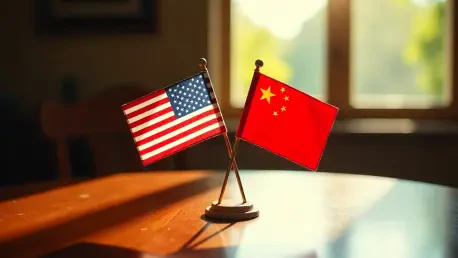Introduction to Rare-Earth Metals and Export Controls
Imagine a world where the backbone of modern technology and defense systems hinges on a single nation’s decisions—China, which controls the lion’s share of rare-earth metals, has just tightened export restrictions, sending shockwaves through global markets. These metals, a group of 17 elements critical for everything from smartphones to missile systems, are at the heart of high-tech and military innovation, making China’s dominance a strategic linchpin. The recent export controls signal a bold geopolitical move, amplifying tensions in an already fraught U.S.-China trade landscape. This analysis delves into China’s motivations behind these restrictions, the profound implications for global supply chains, particularly for the United States, expert perspectives on the strategic intent, and the potential future of this critical resource in international relations.
Background and Scope of China’s Export Restrictions
Specifics of the New Export Control Measures
China’s Ministry of Commerce recently unveiled stringent export controls under announcement number 61, targeting 12 out of the 17 rare-earth metals, including key elements like holmium, erbium, and dysprosium, alongside specialized refining technologies. Effective from December 1, these measures mandate that foreign companies secure special approvals from Beijing and disclose the end-use of products derived from these materials, adding significant bureaucratic hurdles. Exemptions exist for emergency medical or disaster relief purposes, but the overarching intent is clear: to tightly regulate the flow of these vital resources.
Data from the U.S. Geological Survey reveals China’s commanding position, mining approximately 60% and processing nearly 90% of the global rare-earth supply, as corroborated by reports from the Center for Strategic and International Studies (CSIS). This dominance underscores the gravity of the restrictions, as most nations, including major economies, rely heavily on Chinese exports for their technological and defense needs. The controls are not merely procedural but a strategic recalibration of global access to indispensable materials.
Strategic Context and Timing of Restrictions
The timing of these export controls is no coincidence, aligning closely with high-stakes diplomatic engagements such as the anticipated Trump-Xi meeting at the APEC summit in South Korea. Announced just weeks before this pivotal event, the restrictions appear as a calculated move to bolster China’s leverage during ongoing U.S.-China trade negotiations, which are currently underpinned by a fragile 90-day trade truce following earlier tariff skirmishes. This backdrop of economic friction amplifies the significance of China’s decision to wield rare-earth metals as a bargaining tool.
Industries directly impacted include U.S. defense, where rare-earth metals are integral to manufacturing F-35 jets and missile guidance systems, and consumer technology, powering electric vehicles and smartphones. The real-world stakes are immense, as disruptions in supply could delay production timelines and escalate costs for critical equipment. This strategic maneuver by China highlights the vulnerability of dependent nations and sets the stage for intense diplomatic discussions in the coming weeks.
Expert Insights on Motivations and Implications
Strategic Intent Behind China’s Actions
Industry experts provide a nuanced view of China’s motivations, interpreting the export controls as a deliberate tactic to gain an upper hand in trade talks. Gracelin Baskaran from CSIS suggests that Beijing is signaling its readiness to use resource dominance as leverage, especially in negotiations with the U.S., while maintaining a window for dialogue with the delayed implementation. This perspective frames the restrictions as a diplomatic chess move rather than an immediate economic blockade.
Kristin Vekasi from the University of Montana echoes this sentiment, describing the policy as a form of pre-meeting posturing designed to remind global players of China’s indispensable role in rare-earth supply chains. Both analysts agree that the controls are less about immediate disruption and more about establishing a stronger negotiating position. The dual-use nature of these metals, applicable in both civilian and military contexts, further justifies China’s stance on safeguarding national security, as articulated by its Commerce Ministry.
Economic and Security Interdependence
A critical insight from experts centers on the intertwined economic fates of the U.S. and China, despite efforts toward decoupling. The mutual reliance on rare-earth supply chains means that while the U.S. faces potential disruptions in defense and tech sectors, China risks economic backlash if restrictions escalate too far. This delicate balance highlights the complexity of severing ties in a globalized economy, where unilateral actions can have reciprocal consequences.
National security concerns also loom large, with rare-earth metals playing a pivotal role in advanced military technologies. Experts note China’s apprehension about the misuse of these materials in foreign military applications, a concern that aligns with broader global debates on technology transfer. The consensus points to a shared vulnerability, urging caution and dialogue to prevent a spiral of retaliatory measures that could destabilize both economies.
Future Outlook for Rare-Earth Metals and Global Trade
Potential Shifts in Supply Chains
Looking ahead, China’s export controls could catalyze significant changes in global supply chains, prompting nations like the U.S. to accelerate investments in domestic rare-earth production and alternative sourcing. While this shift might reduce dependence on Chinese supplies over time, the immediate challenge lies in the lack of infrastructure and expertise outside China, potentially leading to short-term shortages in critical industries. The push for self-reliance, though strategically sound, requires substantial time and capital.
Benefits and Challenges of the Restrictions
For China, these controls strengthen its geopolitical standing, reinforcing its image as a gatekeeper of vital resources and enhancing its influence in international forums. However, the challenges are equally stark, as global backlash or reduced demand could impact its own economic interests. For the U.S., the restrictions pose risks of disrupted defense capabilities and widened technological gaps, yet they also present an opportunity to prioritize innovation and diversification in resource acquisition.
Broader Implications and Scenarios
The trend of weaponizing critical resources, exemplified by these controls, signals a new era in international relations where economic tools are as potent as military ones. The risk of escalating tensions looms if trade talks falter, potentially leading to harsher retaliations or broader export bans. Conversely, successful negotiations at the APEC summit could yield exemptions or collaborative frameworks, easing immediate pressures. Across industries, from renewable energy to artificial intelligence, the ripple effects of this policy could redefine global competitive dynamics, urging nations to rethink resource security as a cornerstone of national strategy.
Conclusion and Call to Action
Reflecting on the unfolding saga of China’s rare-earth metals export controls, the strategic intent behind tightening access has become a defining moment in global trade dynamics. The profound impact on the U.S. and other dependent economies underscores the fragility of interconnected supply chains. Expert analyses point to a calculated play for geopolitical leverage, while uncertainties about future negotiations linger as a critical concern. Moving forward, policymakers and industry leaders must pivot toward actionable strategies, such as investing in alternative mining regions and fostering international partnerships to secure stable supplies. Establishing robust diplomatic channels to address resource disputes proves essential in mitigating risks, ensuring that this vital sector does not become a perpetual flashpoint in global relations.









